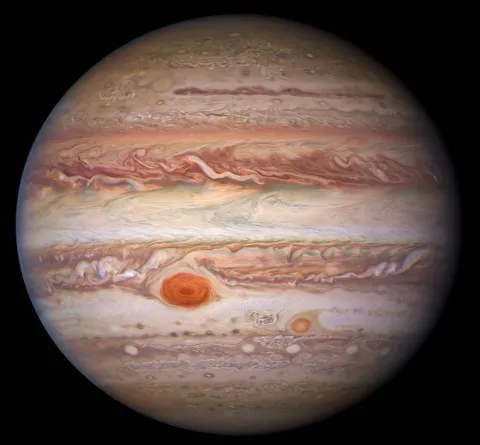
Jupiter, the fifth planet from the Sun, is a colossal gas giant that reigns supreme as the largest planet in our Solar System. Its massive size, intense magnetic field, and swirling cloud bands make it a fascinating subject of study for astronomers and a beacon of mystery in our cosmic neighborhood. With a diameter of approximately 143,000 kilometers (about 89,000 miles), Jupiter is so large that it could fit all the other planets inside it and still have room to spare.
History and Mythology
Jupiter has been known to humanity since ancient times, visible to the naked eye as one of the brightest objects in the night sky. The planet was named after the Roman god Jupiter, the king of the gods, who was equivalent to the Greek god Zeus. In mythology, Jupiter was the god of the sky and thunder, often depicted wielding a thunderbolt, symbolizing his power and authority. The connection between the planet and this mighty deity reflects its dominance and grandeur among the celestial bodies.
Moons of Jupiter
Jupiter is orbited by an extensive retinue of moons, numbering 95 as of the latest observations. The most famous of these are the four Galilean moons: Io, Europa, Ganymede, and Callisto. These moons were discovered by Galileo Galilei in 1610 and are some of the largest and most intriguing satellites in the Solar System.
- Io is the most volcanically active body in the Solar System, with over 400 active volcanoes.
- Europa is believed to harbor a subsurface ocean beneath its icy crust, making it a prime candidate in the search for extraterrestrial life.
- Ganymede is the largest moon in the Solar System, even bigger than the planet Mercury, and has its own magnetic field.
- Callisto is heavily cratered and thought to be one of the oldest landscapes in the Solar System.
Beyond the Galilean moons, Jupiter’s smaller moons and its complex ring system add to the planet’s allure, offering diverse environments for study.
Jupiter Statistics
- Equatorial Diameter: 142,984 km
- Mass: 1.898 × 10^27 kg (318 times Earth's mass)
- Volume: 1,321 times that of Earth
- Density: 1.33 g/cm³ (about a quarter of Earth's)
- Gravity: 24.79 m/s² (2.528 times Earth's gravity)
- Orbital Period: 11.86 Earth years
- Rotation Period: 9 hours 56 minutes
- Atmosphere: Primarily composed of hydrogen (90%) and helium (10%)
- Temperature: Cloud tops average around -145°C (-234°F)
Probes that Visited Jupiter
Pioneer 10 and 11
The Pioneer 10 and 11 missions were the first spacecraft to visit Jupiter in the early 1970s. They provided the first close-up images of the planet and its moons, and their flybys helped to map Jupiter's magnetic field and radiation belts.
Voyager 1 and 2
Launched in 1977, the Voyager missions provided a treasure trove of data about Jupiter and its moons. They revealed intricate details about the planet's atmosphere, discovered active volcanoes on Io, and captured stunning images of the Galilean moons.
Galileo
The Galileo spacecraft, launched in 1989, orbited Jupiter for nearly eight years, conducting detailed studies of the planet and its moons. Galileo discovered evidence of subsurface oceans on Europa and Ganymede, observed comet Shoemaker-Levy 9's collision with Jupiter, and provided extensive data on the planet's atmosphere.
Cassini
Although primarily a mission to Saturn, Cassini conducted a flyby of Jupiter in 2000, capturing high-resolution images and studying the planet's magnetosphere.
Juno
Launched in 2011, Juno is the most recent mission to Jupiter. It entered orbit around the planet in 2016 and has been providing unprecedented data on Jupiter's structure, magnetic field, and auroras. Juno's findings have revolutionized our understanding of the planet's interior and atmosphere.
Fun Facts about Jupiter
- Jupiter's Great Red Spot, a massive storm larger than Earth, has been raging for at least 400 years.
- The planet emits more heat than it receives from the Sun, due to the slow gravitational compression of its massive interior.
- A day on Jupiter (its rotation period) is the shortest of all the planets, lasting only about 10 hours.
- Jupiter's magnetic field is the strongest of any planet in the Solar System, about 20,000 times stronger than Earth's.
- If Jupiter had been about 80 times more massive, it could have become a star instead of a planet.
Plans to Visit Jupiter
While no manned missions to Jupiter are currently planned, several ambitious missions aim to explore the Jovian system further. NASA's upcoming Europa Clipper mission, scheduled for launch in the 2030s, will focus on studying Europa's potential habitability. The European Space Agency's JUICE (JUpiter ICy moons Explorer) mission, also set for the 2030s, will explore Ganymede, Callisto, and Europa, with a particular focus on Ganymede.
These missions will deepen our understanding of Jupiter and its moons, possibly paving the way for future exploration, including robotic landers or even crewed missions, though the latter remains a distant possibility due to the planet's extreme conditions.
Conclusion
Jupiter, the giant of the Solar System, continues to captivate astronomers and space enthusiasts alike. Its vast system of moons, powerful magnetic field, and dynamic atmosphere offer endless opportunities for exploration and discovery. As we continue to unlock its secrets through ongoing and future missions, Jupiter remains a cornerstone of our understanding of planetary science and the broader mechanisms at work in our Solar System.
